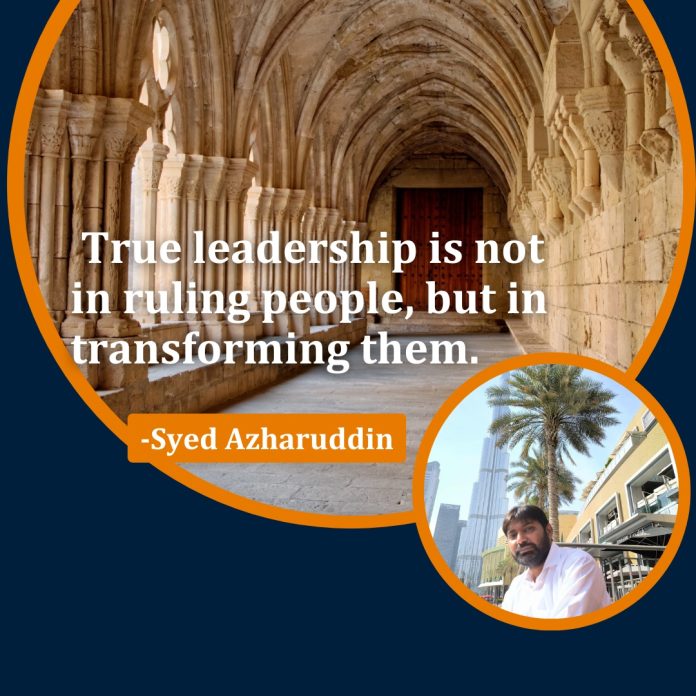✍Syed Azharuddin
Leadership is not only about guidance but about foresight, planning, and execution. Prophet Muhammad ﷺ embodied these traits, not only as the Messenger of God but also as a strategic leader whose decisions reshaped history. His biography (Seerah) reveals patterns of strategic thinking that remain timeless, and modern scholars argue that his actions should be studied as lessons in leadership and statecraft.
Hijrah as Strategy: The Masterstroke of Positioning
Prophet Muhammad ﷺ is most often remembered as the Messenger of God, a man who transformed the moral and spiritual life of humanity. Yet, beyond his role as a religious guide, he stands out in history as a profound strategic leader. His life was not an accidental sequence of events but a demonstration of visionary planning, calculated decision-making, and a keen awareness of human psychology, politics, and geopolitics. As Dr. Tareq Al-Suwaidan has emphasised in his Encyclopedia of Seerah, only a small fraction of the Prophet’s actions – perhaps five per cent – came directly from divine revelation, while the overwhelming majority was the result of thoughtful human judgment, consultation with companions, and strategic foresight. It is in this light that his leadership should be appreciated: not only as inspired, but as methodical and purposeful.
One of the clearest demonstrations of this strategic acumen was the choice of Madinah as the base of the Islamic movement. Five years prior to the migration, the two major tribes of Madinah, Aws and Khazraj, had fought the Battle of Bu‘āth. The war was catastrophic, leaving many leaders dead and creating a vacuum of authority. Ayesha (RA) later remarked that Allah had prepared Madinah for the Prophet through this very conflict. “Allah had brought about the Battle of Bu‘āth before the Hijrah, in which the chiefs of the tribes were killed. So Allah made their war a cause of their acceptance of Islam.” (Sahih al-Bukhari, 3905)
When the people of Madinah invited him to lead, they were not only looking for a spiritual guide but also a statesman who could reconcile them and establish order. From a leadership and decision-making perspective, Madinah offered unique advantages: it was free of entrenched power structures, strategically located on trade routes, and socially primed for reconciliation after years of bloodshed. As Dr. Al-Suwaidan observes, this was not chance but “a masterstroke of positioning,” ensuring that the Prophet Muhammad ﷺ could build a state where no rival political authority existed.
Strategic Investment in the Next Generation
The Prophet Muhammad‘s ﷺ method of leadership was equally strategic in his approach to human capital. He deliberately invested in the younger generation, training them not through formal lectures but through mentorship and direct involvement in real responsibilities. Ali ibn Abi Talib was only 10 when he accepted Islam, Mus‘ab ibn Umair, a young man of remarkable charisma, was sent to Madinah before Hijrah as the first ambassador of Islam. By the time the Prophet Muhammad ﷺ arrived, Mus‘ab had already laid the foundations of faith and unity, proving that preparation precedes execution, and Usama ibn Zayd, only 18, was appointed commander of an army containing senior companions. When some objected to his youth, the Prophet Muhammad ﷺ defended him, saying: “If you criticise his appointment, you also criticised his father’s before him. By Allah, he was worthy of leadership, and he (his son) is also worthy of it.” (Sahih al-Bukhari, 3730). This shows a deliberate strategy: empower the youth early, entrust them with responsibility, and let them grow into leadership roles.
The Prophet trained leaders by living with them, exposing them daily to his decisions, his patience, his struggles. Thirtee years of such training cannot be matched by any formal school.
Shura: The Power of Consultation in Strategy
Consultation was another hallmark of his strategic leadership. Though divinely guided, he never imposed his will unilaterally. Abu Bakr and Umar were called his two “wazirs,” his closest advisers. At Badr, he accepted the tactical advice of Hubab ibn al-Mundhir to change the army’s position. At Uhud, the Prophet Muhammad ﷺ preferred defending Madinah from within, but the youth urged to meet Quraysh outside. Despite his own view, he respected consultation and went forward with their plan (Ibn Kathir, al-Bidaya wa al-Nihaya). This practice demonstrates humility and the principle that good leadership is collective, not autocratic.
At Hudaybiyyah, though the treaty terms seemed humiliating, he pursued peace over pride, recognising that 10 years of stability would open the doors of da‘wah in ways war never could. This pragmatic realism paid off, for Islam spread more in the two years after Hudaybiyyah than in the 19 years before it. This is a genius of separating principles from strategies – while the message was uncompromising, the methods were always flexible.
Strategic Planning on the Global Stage
The Prophet Muhammad ﷺ also demonstrated remarkable geopolitical awareness. The migration to Abyssinia, often described in traditional narratives as an act of desperation, was in fact a calculated move. He identified the Negus of Abyssinia as a just ruler under whom Muslims could find refuge. In this sense, it was a “Plan B” to ensure the survival of the community in case persecution in Makkah intensified. Later, his letters to the rulers of Persia, Byzantium, and Egypt show that he was not a local leader with a tribal vision, but a man with a global mission who understood the wider balance of power.
Karen Armstrong, a contemporary biographer, notes: “Muhammad was never a mere dreamer; he was a practical man of affairs and a strategist who sought ways of making his religious vision a political reality.” (Muhammad: A Biography of the Prophet, 1991).
The Prophet Muhammad ﷺ was deeply aware of the global context of his time. Arabia was overshadowed by the Byzantine (Roman) and Persian empires. His correspondence with emperors, governors, and kings after Hudaybiyyah demonstrates a strategic shift: Islam was no longer a local movement but a global vision. When Quraysh rejected Islam, the Prophet Muhammad ﷺ turned outward, laying the groundwork for an international mission.
Historian Montgomery Watt remarks in Muhammad at Medina that “Muhammad was a man of extraordinary political insight. His political measures were often so well planned that they only achieved their full effect after many years.”
This long-term vision distinguishes him not only as a prophet but also as a strategist of rare calibre and his foresight reflects that leadership is not merely reactive but proactive, anticipating risks and creating alternatives.
The First Constitution and Sustainable Leadership
When Prophet Muhammad ﷺ arrived in Madinah, he immediately set about institution-building, a mark of sustainable leadership. The Constitution of Medina was a pioneering social contract that recognised Jews and Muslims as part of one political community (ummah), united in mutual defence. It was perhaps the first written constitution in history to guarantee rights for multiple faith groups under one authority. The Masjid Nabawi was not merely a place of worship but a parliament, a court, a school, and a centre of governance. Through the pact of brotherhood between Muhajirun and Ansar, he ensured economic stability and social integration.
Karen Armstrong, in Muhammad: A Prophet for Our Time, comments that “Muhammad created a new kind of community in Medina, where tribal divisions were transcended by a higher moral vision.” This shows his ability to transform fragmented groups into a cohesive society and a systematic strategy of state-building – addressing social, economic, political, and spiritual needs simultaneously.
Winning Hearts Through Strategic Mercy
Yet, perhaps the most striking aspect of his leadership was the balance between idealism and realism. He never compromised the core message of tawheed, but on political and military matters, he chose pragmatism. The Treaty of Hudaybiyyah is one example; the Conquest of Makkah is another. After years of persecution and war, he entered Makkah not as a conqueror seeking revenge but as a leader granting amnesty. By forgiving his enemies, he won hearts rather than simply capturing a city.
Michael Hart, in The 100: A Ranking of the Most Influential Persons in History, places Muhammad ﷺ at the very top, noting: “He was supremely successful on both the religious and secular levels.” Such acknowledgment, even from non-Muslim scholars, reinforces the reality that his leadership was holistic and strategic in nature.
Seerah: A Manual of Strategy and Leadership
Prophet Muhammad ﷺ was a Messenger of God; he was also one of history’s greatest strategists. He built a state out of chaos, nurtured leaders out of youth, institutionalised governance in record time, and expanded a vision that continues to shape civilizations. His legacy teaches us that leadership is not merely about power or charisma but about foresight, preparation, consultation, and mercy.
The Seerah is not only a record of the past. It is a manual of strategy, a living textbook of leadership. For Muslims today – and indeed for all humanity – the Prophet’s life remains an enduring model of how vision, faith, and strategy can transform societies. For modern leaders, the Seerah is not only a source of inspiration but a manual of strategy – showing how vision, planning, consultation, youth empowerment, and institution-building can transform society.




